Gregory A. Fournier's Blog, page 42
September 13, 2013
The Lost John Norman Collins Movie - Part Two of Three
 Now I Lay Me Down To Sleep was writer/producer/director William Martin's attempt to tell the story of the coed killings, alleged to be committed by John Norman Collins in Ypsilanti and Ann Arbor, Michigan, between 1967 and 1969. The title comes from the well-known children's prayer.
Now I Lay Me Down To Sleep was writer/producer/director William Martin's attempt to tell the story of the coed killings, alleged to be committed by John Norman Collins in Ypsilanti and Ann Arbor, Michigan, between 1967 and 1969. The title comes from the well-known children's prayer.Martin made an earlier film in Michigan called Jacktown, the nickname for the world's largest walled prison at the time - Jackson State Prison. It was an uneasy mix of documentary footage from the Jackson prison riot in the 1950s, location shooting in Royal Oak, Michigan, and an uninspired script with wooden acting. What makes this movie fun to watch is how really bad it is.
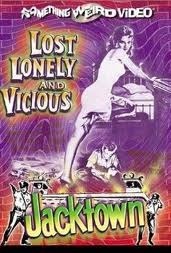 As with Jacktown, Martin used seasoned actors in the lead roles for Now I Lay Me Down To Sleep and wanted some local talent to play several of the murdered girls. Local actress, Kathy Pierce of Chelsea, Michigan, was chosen to play the role of Karen Sue Beineman, the only murdered coed Collins was convicted of killing. Allison Date from Ann Arbor had also been cast as one of the victims.
As with Jacktown, Martin used seasoned actors in the lead roles for Now I Lay Me Down To Sleep and wanted some local talent to play several of the murdered girls. Local actress, Kathy Pierce of Chelsea, Michigan, was chosen to play the role of Karen Sue Beineman, the only murdered coed Collins was convicted of killing. Allison Date from Ann Arbor had also been cast as one of the victims.As other writers have done in the past, Martin changed the names of the victims, which over time has obscured the girls' identities. Karen Sue Beineman was renamed Carol Ann Gebhardt in one account, Karry B. in another, and Norma Jean Fenneman in Martin's movie. By my count, the seven victims are referred to by no fewer than twenty-eight names in various treatments of this material. Is it any wonder the public is so confused about this case? John Norman Collins' character was to be called Brian Caldwell, played by veteran actor, Robert Purvey (See bio link for more information about him).
At first, Martin said he encountered lots of local resistance, but after the The Michigan Murders came out in 1976, resistance became pointless. Then, Collins' lawyers tried to get an injunction against the film because it prejudiced the appeals process against their client. At his own expense, Martin, offered to close down production of his film if John Collins would take a lie-detector test exonerating himself. He never did.
More serious was an Ann Arbor News report from July 30th, 1977, about William Martin being approached by "a large man with a beard" at about 10:00 AM as he was preparing for the day's shoot. The burly man poked his finger into Martin's chest and told him, "You, you're dead. We'll kill you!" Afterwards, Martin told of other threats to him and some of the film's stars. The article goes on to say, "a truckload of road blocks led some to believe that this film would never be made."
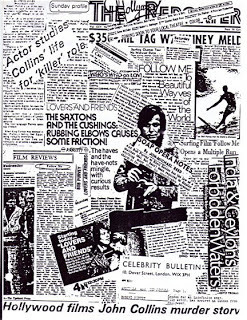 Last week, actor Robert Purvey contacted my researcher with a different story. He said that Martin had only half a script and asked Purvey to help write the story as they went along. They spent their days on location and their evenings feverishly preparing for the next day's shooting. Once the crew returned to Hollywood, there were additional studio scenes to shoot and post production costs skyrocketed, so the project was shelved.
Last week, actor Robert Purvey contacted my researcher with a different story. He said that Martin had only half a script and asked Purvey to help write the story as they went along. They spent their days on location and their evenings feverishly preparing for the next day's shooting. Once the crew returned to Hollywood, there were additional studio scenes to shoot and post production costs skyrocketed, so the project was shelved.Probably just as well. The story of the murders of these young woman deserves to be told accurately - not cobbled together like some mystery movie of the week. If William Martin's early film, Jacktown, is any indication, it is better that Now I Lay Me Down To Sleep never saw the light of day.
Post mortem on NILMDTS in part three.
http://www.bobpurvey.com/biography.html
http://www.imdb.com/title/tt0182253/ Jacktown free movie download.
Published on September 13, 2013 09:16
September 10, 2013
The Lost John Norman Collins Movie - Part One of Three
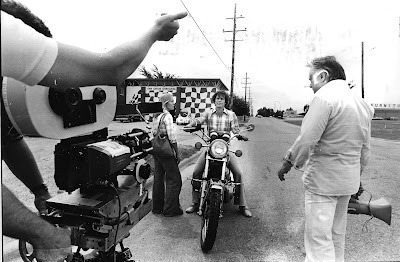
In early 1977, a film crew of thirty-five people from Hollywood descended upon the communities of Ypsilanti and Ann Arbor, Michigan, to make a film about John Norman Collins, the all-American boy and Eastern Michigan University student, who allegedly murdered seven young women in the area.
Producer/director/writer, William Martin, took five years to write the screenplay and insisted that it was not at all connected with The Michigan Murders, which was released a year earlier in 1976. Martin's movie was to be more of a mood piece about the community in crisis rather than "factual" details. The movie was entitled, Now I Lay Me Down To Sleep.
"It's not a police story," Martin told reporters. "The whole county was in terror for two years. I'm only doing it from the standpoint of what was running through the minds of the girls, what was happening in the community, and what was happening with the killer at large."
What was happening with the killer is still a story begging to be told. John Norman Collins has steadfastly maintained he is innocent.
The budget for this film ranged from early estimates of 1 million dollars to a soaring 2.5 million in total production costs. The film was slated by Paramount Pictures for its Ypsilanti premiere around Christmas time in 1978, but the film was never completed. Somewhere in a vault or storage locker lies footage from a film never before seen by the public.
Martin planned to change the names of the victims as Edward Keyes and others have done, but below and in my book on this subject, The Rainy Day Murders, I've used the real names of the people and the actors who played them.
Malibu surf legend, Robert Purvey, was cast as John Norman Collins; Rory Calhoun portrayed Washtenaw County Sheriff, Douglas Harvey; Katherine Grayson, of 1940's MGM musical fame, was to play Collin's aunt, Sandra Leik; Peter Hurkos agreed to play himself with little or no persuasion; and local Detroit WXYZ anchorman, Bill Bonds, reprised his role as a field reporter which he had previously played in a couple of Planet of the Apes movies and Five Easy Pieces.
Reasons why the film was never completed range from John Collins lawyers trying to get a court injunction to stop production to personal threats against the producer. Recently, my researcher, Ryan Place, has been in contact with Robert Purvey who sheds new light on why this movie was never made. More on that in my next post.
To be continued...
Published on September 10, 2013 06:32
September 6, 2013
Joyce Maynard's New Novel, After Her, and the Current Movie Based on Her Novel, Labor Day
 Wednesday night, I had the pleasure of attending one of Joyce Maynard's book talks at Warwick's independent bookstore in La Jolla, California. She was promoting her current novel, After Her. When her presentation ended, we chatted briefly afterwards and exchanged books.
Wednesday night, I had the pleasure of attending one of Joyce Maynard's book talks at Warwick's independent bookstore in La Jolla, California. She was promoting her current novel, After Her. When her presentation ended, we chatted briefly afterwards and exchanged books.After Her is a novel loosely based on The Trailside Killer case in Marin County, California in the late 1970s. Joyce tells the tale of two sisters and their love for their philandering, detective father whose job it is to capture the Trailside Killer. After Her is a complex thriller which is a real page turner.
Joyce may be best known for the novel To Die For, which was made into a movie directed by Gus Van Sant, starring Nicole Kidman in one of her best roles ever.
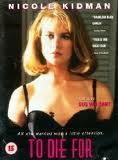
An aspiring local weather girl will do whatever it takes to make it in television, even having her husband murdered by three teens. The movie is better than I made it sound. It is a dark comedy based on a real incident.
Joyce Maynard's book, Internal Combustion, is about Nancy Seaman, an award winning fourth grade teacher, who went to Home Depot and bought an axe to kill her ex-Ford Motor Company engineer husband in the garage of their Farmington Hills, Michigan home.
 Mrs. Seaman attempted to use the "battered wife" defense, but her trial revealed a disturbing history of family dysfunction and a pattern of sociopathic behavior on her part. When Joyce started writing this story, she instinctively sided with the wife, but upon closer examination of the facts and her own research, another picture of Nancy Seaman emerged which made Joyce change her mind about the case.
Mrs. Seaman attempted to use the "battered wife" defense, but her trial revealed a disturbing history of family dysfunction and a pattern of sociopathic behavior on her part. When Joyce started writing this story, she instinctively sided with the wife, but upon closer examination of the facts and her own research, another picture of Nancy Seaman emerged which made Joyce change her mind about the case.Joyce Maynard's novel Labor Day has been made into a film and is currently showing in theaters. It is directed by Jason Reitman and stars Kate Winslet, Josh Brolin, and Toby Maguire. I haven't seen this yet, so I won't comment on it.
Joyce did said she met documentary filmmaker, Micheal Moore, at the Telluride Film Festival recently after a screening of Labor Day. He was coming out of the male restroom and spotted her.
"You won't believe what's going on inside the male restroom, Joyce," he said suppressing a grin.
"What?" she asked, waiting for the punchline.
"Grown men are in there crying their eyes out."
I have to see this movie.
 Joyce MaynardIn the link below, Joyce criticizes the new Ken Burns' documentary about J.D. Salinger, having been an eighteen year old victim of the predatory Salinger.
Joyce MaynardIn the link below, Joyce criticizes the new Ken Burns' documentary about J.D. Salinger, having been an eighteen year old victim of the predatory Salinger.When asked why she participated in the biography, she replied, "I decided that I would speak for myself rather than have others speak about me."
http://www.globalpost.com/dispatch/news/thomson-reuters/130904/telluride-joyce-maynard-slams-salinger-documentary-says-author-
Published on September 06, 2013 18:30
September 4, 2013
Fornology on Web Radio - This Friday, September 6th - 8:30 PM Eastern/5:30 PM Pacific Time
My interview cancelled from last week had technical difficulties but was rescheduled for this Friday. I hope you can listen in. Call me if you have a question. Thanks!

This Friday, September 6th, I’ll be doing a live web radio interview for The Patrick Walters Showout of Roxboro, North Carolina. I’ll be talking about my book, Zug Island: A Detroit Riot Novel and topics related to it. I hope to steer the interview towards the subject of my current project, serial killer John Norman Collins and The Rainy Day Murders .
This live webcast is on
http://www.blogtalkradio.com/trianglevariety
8:30 PM Eastern time/5:30 PM Pacific timeFriday, September 6th, 2013
This is a call-in show. If you have any questions about my books or my blog <fornology.blogspot.com>, the number to call is (949) 272-9578. Drop me a line!

This Friday, September 6th, I’ll be doing a live web radio interview for The Patrick Walters Showout of Roxboro, North Carolina. I’ll be talking about my book, Zug Island: A Detroit Riot Novel and topics related to it. I hope to steer the interview towards the subject of my current project, serial killer John Norman Collins and The Rainy Day Murders .
This live webcast is on
http://www.blogtalkradio.com/trianglevariety
8:30 PM Eastern time/5:30 PM Pacific timeFriday, September 6th, 2013
This is a call-in show. If you have any questions about my books or my blog <fornology.blogspot.com>, the number to call is (949) 272-9578. Drop me a line!
Published on September 04, 2013 21:25
September 2, 2013
Public School Education - Not a Melting Pot - But a Rich, Savory Stew by guest blogger Roger Huie
 I've long considered myself lucky to have spent my career as a high school teacher, particularly in a school that served a multi-ethnic and multi-socioeconomic student population. I saw that regardless of background almost all students want an education and worked to get one. That even the ones who didn't appear to care about their education actually did care. Sometimes I wouldn't recognize this until years later when I would run into an apparent underachiever who was doing quite nicely in his/her life, who was pleased for the opportunity to share this and to tell me that I and other teachers had made a difference.
I've long considered myself lucky to have spent my career as a high school teacher, particularly in a school that served a multi-ethnic and multi-socioeconomic student population. I saw that regardless of background almost all students want an education and worked to get one. That even the ones who didn't appear to care about their education actually did care. Sometimes I wouldn't recognize this until years later when I would run into an apparent underachiever who was doing quite nicely in his/her life, who was pleased for the opportunity to share this and to tell me that I and other teachers had made a difference. I also realized that not every student starts with the same opportunities. The children of the poor and illiterate, even if they have the same native intelligence, start out considerably behind the children of middle and professional classes. If you've not been read to, if there's no reading material in the home outside of food labels, if you are not surrounded by the products of success or even the hope of it, then academic achievement, let alone financial achievement may not be a priority or even seem a realistic goal.
Nor is every student destined to be a rocket scientist. Most teachers take each student from where they are when they enter their classroom and try to take them as far as they can go. This is why, even though I coached most of my career, I minimized competition in my classroom: If we are trying to lift all students why create an environment in which there are winners and losers. The ultimate competition is with yourself, whether in academia or in sport. We should encourage students to achieve to the best of their ability, and understand that not all of them will achieve the same heights.
 Finally, I was lucky to work with colleagues from a variety of ethnic groups and all walks of life that were, no matter our differences, united in our efforts to help our students achieve. Knowing white, black, Hispanic, Asian, Christians, Muslims, and Jews (I could go on) as professional educators helped alleviate many of the prejudices humans are heir to. And to those who are still engaged in teaching, I commend you for your efforts. Regardless of the bad press that swirls around our profession, if you are doing your job, your students know it, even if they don't recognize it or acknowledge it now.One teacher answers the question, "What do you make?"
Finally, I was lucky to work with colleagues from a variety of ethnic groups and all walks of life that were, no matter our differences, united in our efforts to help our students achieve. Knowing white, black, Hispanic, Asian, Christians, Muslims, and Jews (I could go on) as professional educators helped alleviate many of the prejudices humans are heir to. And to those who are still engaged in teaching, I commend you for your efforts. Regardless of the bad press that swirls around our profession, if you are doing your job, your students know it, even if they don't recognize it or acknowledge it now.One teacher answers the question, "What do you make?"https://www.youtube.com/watch?v=h5yg0u1MkDI
Published on September 02, 2013 08:32
September 1, 2013
Zug Island: A Detroit Riot Novel by Gregory A. Fournier - Book Review by Dr. Robert Rose
Tuesday, 13 August 2013
When Greg sent me his book, I assumed it was going to be about racism and the causes of the Detroit Riot in 1967. During that time I was teaching in an all black school of 800 in San Bernardino, California, and I knew full well how the tentacles of racism were choking the life from my students.
 I was somewhat correct that it was about racism, but seen through the eyes of an eighteen year old white boy (Jake) who had never even been close to a black person. It is much more than that, it is a wonderful story about two young men, one white and one black who transcend their backgrounds and group prejudice to see one another as - human beings. The ending brought tears of joy and pride in what could be accomplished when we can erase what we’ve been taught and see one another freshly and fairly as uniquely human.
I was somewhat correct that it was about racism, but seen through the eyes of an eighteen year old white boy (Jake) who had never even been close to a black person. It is much more than that, it is a wonderful story about two young men, one white and one black who transcend their backgrounds and group prejudice to see one another as - human beings. The ending brought tears of joy and pride in what could be accomplished when we can erase what we’ve been taught and see one another freshly and fairly as uniquely human.The long section that describes his time on Zug Island was interesting and terrifying. It reminded me of when I read The Jungle by Upton Sinclair. My uncle had told me when he had worked in a meat packing plant in the Thirties he had been standing on a large piece of meat. When his shift was over he threw it into the garbage.
The foreman saw him and ordered him to put it on the conveyor line to process. My uncle refused and was fired. That was minor compared to the horrors the children and poor immigrants endured in losing limbs and lives without insurance or medical treatment in the factories.
 Zug Island was a living Hell. The furnaces were insatiable and the heat was unbearable, the smoke and dust were destroying their lungs, and the physical work only a man desperate for a job would take. 99% of the laborers were poor blacks, mostly from the deep South. Jake stood out as one of the few whites. It was the fact that his grandfather and father had worked there and were respected that he was given the chance to prove himself. That he did.
Zug Island was a living Hell. The furnaces were insatiable and the heat was unbearable, the smoke and dust were destroying their lungs, and the physical work only a man desperate for a job would take. 99% of the laborers were poor blacks, mostly from the deep South. Jake stood out as one of the few whites. It was the fact that his grandfather and father had worked there and were respected that he was given the chance to prove himself. That he did.Theo, a young married black who worked to make enough to hopefully get out of there and move his family back home, became Jake’s mentor and friend. Through Theo and the others, Jake saw a side of America he had no idea existed. The overwhelming frustrations from lack of a decent education, the fact that last hired, first fired was a reality that black men dealt with by taking it out on each other. Attacking any of the causes or any white person meant facing a justice system that they knew was unjust for them.
It didn’t make sense to most people why during the 1967 Detroit Riots, and other such outbreaks, that blacks destroyed their own neighborhoods. It was a build-up of intense anger from the reality of their helplessness against so many societal institutions that were keeping them down.
 As teachers, Greg and I taught minority students and found ways to overcome their helplessness by building trust and caring relationships. Changing their negative mindsets through activities proved to them that they could be academically and socially successful and responsible for their actions.
As teachers, Greg and I taught minority students and found ways to overcome their helplessness by building trust and caring relationships. Changing their negative mindsets through activities proved to them that they could be academically and socially successful and responsible for their actions.Unfortunately, despite all the money poured into the minority schools and the pathetic attempts at real integration, and the fact that many lives did improve, the sense of inferiority and helplessness is the reality for millions today.
Greg’s book with his emphasis on the possibilities of real friendship between different races is proof that it can happen. It is a feel good book that you won’t want to put down until the end.
http://zugislandthenovel.com
Published on September 01, 2013 19:43
August 30, 2013
Photographic History Brought Back To Life
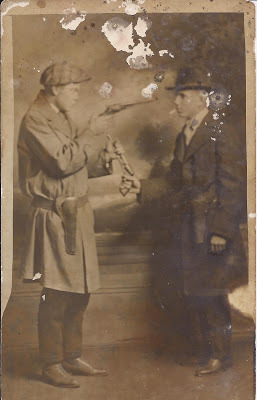 Will Holland and friend - 1925In 1925, Will Holland stopped into a photography shop with a friend and had a novelty photograph taken. He and my grandmother had emigrated from Tennessee to Detroit in the 1920s looking for work.
Will Holland and friend - 1925In 1925, Will Holland stopped into a photography shop with a friend and had a novelty photograph taken. He and my grandmother had emigrated from Tennessee to Detroit in the 1920s looking for work. One of the first jobs he was able to find was driving a truck, running bootleg liquor from Canada throughout the Detroit area for a group of Irish entrepreneurs. In the winter, he would drive across the frozen Detroit River to make pickups and deliveries.
My grandfather gave this photograph to my mother before he died in the late 1930s. Not much is known about him because my grandparents were divorced, and my grandmother attempted to purge all memory of him from her life. My mother kept the photograph of her father secretly hidden.
When my mother passed on several years ago, I received the photograph in an envelope with some more recent family photos. I tucked the envelope away for safe keeping and forgot about it until last week when I was looking for something else.
The quality of the photo had really deteriorated. It had gone from bad to worse. Not only had it faded over the decades, it had turned brown and the photo paper was beginning to separate. I decided to see if it could be restored because I wanted to preserve this bit of family history and make prints for the rest of the family.
I discovered the name of a local San Diego photo restorer from an ad on Facebook and gave him a call. Paul Hartsuyker is a retired Mesa College professor who has taught Photoshop workshops for twenty years. After he retired, he decided to go pro. See the link.
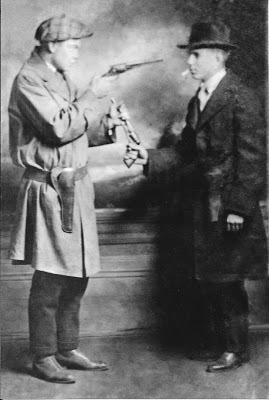 Restored photograph
Restored photographI was able to sit next to him while he explained what he was doing.
"Digitally manipulating an antique photograph is an exercise in give and take. For example, do you sacrifice detail for contrast and brightness?"
He went back and forth like an optometrist, "Do you like this one or this one?" He allowed me to make decisions as he worked on the photo.
I was quite pleased with the result. I would have liked more clarity, but there was only so much that the original had to give. This picture freezes a moment in time and captures a gag snapshot which is one of my most cherished family photographs.
http://www.hartworks.net/photorestore/offer.htm
Published on August 30, 2013 17:02
August 28, 2013
Fornology on Web Radio - This Friday, September 6th - 8:30 PM Eastern/5:30 PM Pacific Time
My interview cancelled from last week had technical difficulties but was rescheduled for this Friday. I hope you can listen in. Call me if you have a question for me. Thanks!

This Friday, September 6th, I’ll be doing a live web radio interview for The Patrick Walters Showout of Roxboro, North Carolina. I’ll be talking about my book, Zug Island: A Detroit Riot Novel and topics related to it. I hope to steer the interview towards the subject of my current project, serial killer John Norman Collins and The Rainy Day Murders .
This live webcast is on
http://www.blogtalkradio.com/trianglevariety
8:30 PM Eastern time/5:30 PM Pacific timeFriday, September 6th, 2013
This is a call-in show. If you have any questions about my books or my blog <fornology.blogspot.com>, the number to call is (949) 272-9578. Drop me a line if you’ve nothing better to do this Labor Day weekend.
http://www.blogtalkradio.com/trianglevariety/2013/08/31/patricks-friday-night-review-with-gregory-a-fournier

This Friday, September 6th, I’ll be doing a live web radio interview for The Patrick Walters Showout of Roxboro, North Carolina. I’ll be talking about my book, Zug Island: A Detroit Riot Novel and topics related to it. I hope to steer the interview towards the subject of my current project, serial killer John Norman Collins and The Rainy Day Murders .
This live webcast is on
http://www.blogtalkradio.com/trianglevariety
8:30 PM Eastern time/5:30 PM Pacific timeFriday, September 6th, 2013
This is a call-in show. If you have any questions about my books or my blog <fornology.blogspot.com>, the number to call is (949) 272-9578. Drop me a line if you’ve nothing better to do this Labor Day weekend.
http://www.blogtalkradio.com/trianglevariety/2013/08/31/patricks-friday-night-review-with-gregory-a-fournier
Published on August 28, 2013 16:47
Fornology on Web Radio - This Friday, August 30th - 8:30 PM Eastern/5:30 PM Pacific Time

This Friday, August 30th, I’ll be doing a live web radio interview for The Patrick Walters Showout of Roxboro, North Carolina. I’ll be talking about my book, Zug Island: A Detroit Riot Novel and topics related to it. I hope to steer the interview towards the subject of my current project, serial killer John Norman Collins and The Rainy Day Murders .
This live webcast is on
http://www.blogtalkradio.com/trianglevariety
8:30 PM Eastern time/5:30 PM Pacific timeFriday, August 30th, 2013
This is a call-in show. If you have any questions about my books or my blog <fornology.blogspot.com>, the number to call is (949) 272-9578. Drop me a line if you’ve nothing better to do this Labor Day weekend.
http://www.blogtalkradio.com/trianglevariety/2013/08/31/patricks-friday-night-review-with-gregory-a-fournier
Published on August 28, 2013 16:47
August 24, 2013
My 200th Fornology Blog Post
 When I started writing my Fornology blog in May of 2011, I was a techno-dweeb.
When I started writing my Fornology blog in May of 2011, I was a techno-dweeb. My publicist, Paula Margulies, explained the importance of blogging in this brave new world of digital publishing for launching a novel, establishing a brand, and building an audience. It takes time and persistence, she said. Truthfully, I wasn't enthused and thought I'd be long finished with it by now. That was more than two years ago.
Now, after over 40,000 hits and 200 posts on a variety of subjects, I've graduated to the rank of cybernaut. I actually enjoy the routine of writing a post every week and the immediate gratification of instant publishing.
Content is king and despite some of the dark and sordid subject matter in some of my posts, many others deal with lighter topics. Several of them talk about blogging and writing like this one does.
Forty of my posts deal with the topic of John Norman Collins and the Washtenaw County, Michigan murders of the late 1960s. Blogging has allowed me to focus on bits and pieces of the larger story, which will be woven into whole cloth when my true crime history of these murders comes out late next year. The Rainy Day Murders will be the culmination of three years of intensive research into these matters and forty-five years of thinking about them.
As well as raising awareness of the topic, Fornology has also been a vehicle for people to come forward with information about John Norman Collins, their personal connection regarding these tragic murders, or their knowledge of the victims.
People still support Collins and maintain that he is innocent, but they never contribute any evidence to support their claims. Then there are the people who need to tell their story. Some of these stories don't always pass the sniff test, but many of them do. We try to corroborate every story before we use it.
 Blogging is helping me create an audience for The Rainy Day Murders project while I finish writing it.
Blogging is helping me create an audience for The Rainy Day Murders project while I finish writing it. I am astounded at the global reach of my blog and often wonder who my readers are on the world wide web and how many of you are regulars.
Recently, it has come to my attention that Fornology has a new fan. Not a fan so much as a critic - John Norman Collins no less.
Prisoners don't have unrestricted access to the internet, but they can send emails, write and receive written or typed letters, and make collect phone calls to landlines.
Collins has heard about some of my posts from people who write to him and even from some of the prison guards. He may not have internet services, but nonetheless, John Norman Collins has one Hell of a grapevine.
Published on August 24, 2013 19:41



